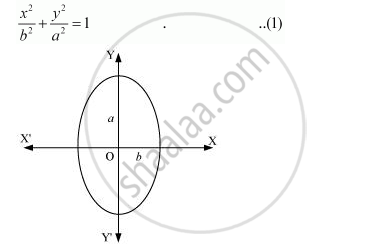Advertisements
Advertisements
प्रश्न
Form the differential equation of the family of ellipses having foci on y-axis and centre at origin.
उत्तर
The equation of the family of ellipses having foci on the y-axis and the centre at origin is as follows:


This is the required differential equation.
APPEARS IN
संबंधित प्रश्न
Form the differential equation of the family of circles touching the y-axis at the origin.
For the curve y = 5x – 2x3, if x increases at the rate of 2 units/sec, then find the rate of change of the slope of the curve when x = 3
Show that the family of curves for which `dy/dx = (x^2+y^2)/(2x^2)` is given by x2 - y2 = cx
Form the differential equation from the following primitive where constants are arbitrary:
y2 = 4ax
Form the differential equation from the following primitive where constants are arbitrary:
y = cx + 2c2 + c3
Form the differential equation from the following primitive where constants are arbitrary:
y = ax2 + bx + c
Form the differential equation corresponding to y2 = a (b − x2) by eliminating a and b.
Form the differential equation corresponding to y2 − 2ay + x2 = a2 by eliminating a.
Represent the following families of curves by forming the corresponding differential equations (a, b being parameters):
x2 − y2 = a2
Represent the following families of curves by forming the corresponding differential equations (a, b being parameters):
(x − a)2 − y2 = 1
Represent the following families of curves by forming the corresponding differential equations (a, b being parameters):
x2 + y2 = ax3
Represent the following families of curves by forming the corresponding differential equations (a, b being parameters):
y = eax
Form the differential equation of the family of circles in the second quadrant and touching the coordinate axes.
Show that y = bex + ce2x is a solution of the differential equation, \[\frac{d^2 y}{d x^2} - 3\frac{dy}{dx} + 2y = 0\]
Find one-parameter families of solution curves of the following differential equation:-
\[x\frac{dy}{dx} - y = \left( x + 1 \right) e^{- x}\]
Find one-parameter families of solution curves of the following differential equation:-
\[e^{- y} \sec^2 y dy = dx + x dy\]
Find the area of the region bounded by the curves (x -1)2 + y2 = 1 and x2 + y2 = 1, using integration.
Find the differential equation of the family of lines through the origin.
Find the differential equation of system of concentric circles with centre (1, 2).
Find the equation of a curve passing through (2, 1) if the slope of the tangent to the curve at any point (x, y) is `(x^2 + y^2)/(2xy)`.
The differential equation of the family of curves x2 + y2 – 2ay = 0, where a is arbitrary constant, is ______.
Family y = Ax + A3 of curves will correspond to a differential equation of order ______.
The curve for which the slope of the tangent at any point is equal to the ratio of the abcissa to the ordinate of the point is ______.
The differential equation representing the family of circles x2 + (y – a)2 = a2 will be of order two.
Differential equation representing the family of curves y = ex (Acosx + Bsinx) is `("d"^2y)/("d"x^2) - 2 ("d"y)/("d"x) + 2y` = 0
The area above the x-axis and under the curve `y = sqrt(1/x - 1)` for `1/2 ≤ x ≤ 1` is:
From the differential equation of the family of circles touching the y-axis at origin
Form the differential equation of family of circles having centre on y-axis and raduis 3 units
Form the differential equation of the family of hyperbola having foci on x-axis and centre at origin.
